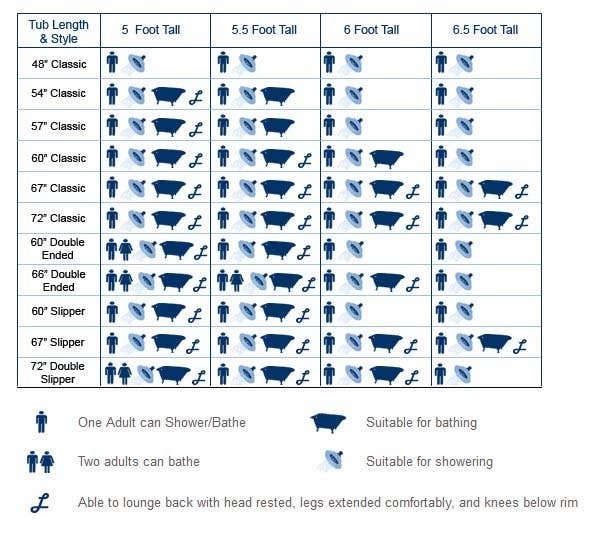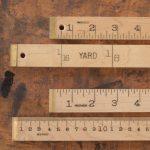Bath Size Chart and Sizing Guide
Baths, often known as bathtubs or tubs, are containers used to store water while bathing. They are typically made of thermoformed acrylic or porcelain steel. Baths are calming for most people, and some even enjoy soaking in them while reading a nice book or sipping a glass of wine (skip straight to the bath size chart).

Apart from these, there are numerous more reasons why people like to have baths in their bathrooms, including how they transform the space, serve as a focal point for the area, and significantly increase the home’s value. Furthermore, scientists have shown that regular bathing has various health benefits, including enhanced blood circulation, muscle pain relief, reduced tension and anxiety, and improved skin.
Related: Sink Base Cabinet Size Chart – Your Guide to the Standard Sizes, Boiler Size Chart – What size boiler do I need?
Summary
- Why is the right bath size important?
- Bath Size Chart
- How to Choose the Right Bath Size for You
- Frequently Asked Questions of Bath Size
Why is the right bath size important?
While having a bathtub appears to have numerous advantages, there are numerous aspects to consider before purchasing one, including the bathroom’s style, bathroom space, materials, bathtub price range, installation cost, bathtub weight, and bathtub size. One of the most crucial factors to consider is the bathtub size.
This is because a bathtub can take up a lot of space in the bathroom, making it feel cluttered. Because the bathroom generally contains several large elements, such as the toilet, vanity, and shelves, evaluating how much space the bathtub will need is critical before purchasing it.
This page includes a bath size chart that will assist you in determining the appropriate bathtub size for you, as well as further information on selecting the optimum bath size for you and answers to some frequently asked questions.

Skip straight to the Frequently Asked Questions part
Bath Size Chart
Below is an overview of standard bath sizes in houses and appartments
| Bath Type | Typical Length (in, cm) | Width (in, cm) | Height (in, cm) |
| Alcove Bath | 60’’ 152.4cm | 30’’ 76.2cm | 18’’ 45.7cm |
| Corner Bath | 60’’ 152.4cm | 60’’ 152.4cm | 22’’ 55.9cm |
| Oval Bath | 60’’ 152.4cm | 41’’ 104.14cm | 24’’ 61cm |
| Freestanding Bath | 55-72’’ 139.7-182.9cm | 27-32’’ 68.6-81.3cm | 15-20’’ 38.1-50.8cm |
| Drop-in Bath | 45-72’’ 114.3-182.9cm | 30-32’’ 76.2-81.3cm | 14-20’’ 35.6-50.8cm |
| Whirlpool bath | 60’’ 152.4cm | 32-36’’ 81.3-91.4cm | 18-24’’ 45.7-61cm |
Related: Boiler Size Chart – What size boiler do I need? – Beach towel size chart for all occasions, couples, adults and kids
How to Choose the Right Bath Size for You
When designing or refurnishing their bathrooms, many homeowners wonder, “What size bath do I need?” Many homeowners make the mistake of ordering a bath without first determining what size bath is ideal for their room. This section will explain how to measure your bathtub before placing an order.
Before purchasing a bathtub, the length, width, and height must all be measured. If you want to replace your current bath, you must first measure it; otherwise, you can measure the area where you want to put your bathtub as your bath dimensions can help determine the right bath size for you.
- Length of the Bath
The longest part of the bathtub is the length of the bath; in curved or corned bathtubs, the longest side is the length of the bath. Take this in centimeters or inches with a tape measure.
- Width of the Bath
Take the length from the back of the bath to the front with a tape measure to get the width of the bathtub.
- Height of the bath
Take a tape measure across the exterior length from the floor to the top border of the bath to determine the bath’s height. The interior length from the bath’s floor to its top edge is used to determine the bath’s depth.
- Type of Bathtub
Bathtubs come in a variety of shapes and sizes; some are better suited to small areas, while others are adequate for larger bathrooms. The sort of bath chosen may be influenced by the user’s bathroom layout, theme, and other features in the bathroom.
The little alcove bathtub, for example, is 54 inches long and 30 inches wide, making it one of the tiniest bathtubs on the market and ideal for people with small bathrooms who don’t want to settle for a shower.
Larger alcove bathtubs are available, as many bathtubs are available in both large and small sizes. Depending on the personal preferences of the user, a freestanding bathtub can be as small as 47 inches long and as large as 72 inches long.
More house-related Size Charts: Coffee table Size Chart – Coffee table dimensions, Bed Size Chart – Measurements And Dimension for king, queen,… beds, Sofa Size and dimension guide for all kind of couches
Bath Size and Measurements explained (video)
Frequently Asked Questions of Bath Size
What sizes do baths come in the UK?
Due to differences in sizing units, bath sizes in the United Kingdom differ slightly from those in the United States. In the United Kingdom, bathtubs have a standard size of 1700mm (5.5 feet) by 700mm (2.2 feet).
Is a 1600mm bath big enough?
Depending on the type and width of the bathtub, a 1600mm bath might be deemed small or medium. Cornered baths are normally 1600mm to 1800mm long and are considered tiny baths. Double-ended baths, which are considered standard-sized baths, are typically around 1600mm-1900mm (5.3-6.2 feet) in length. Thus, depending on the bath’s style, a 1600mm bath may be sufficient.
Is 1.5 m bath too small?
Yes, a 1.5m (4.9 feet) bath is typically only found in smaller-styled bathrooms such as the free-standing bath or the alcove bathtub. It’s usually warm and inviting, and it gives the room a more traditional look. Other bathtub lengths are typically greater than 1.5m.
What is a standard bath size?
While there is a wide range of sizes in the market, the standard bath size is 60” in length and 30-32” in width. Most bathtub types including alcove baths, cornered baths, and oval baths all have this size, which is considered the average size of bathtubs in the market.
How big is a bath in liters?
A normal bath holds around 302 liters of water, which is roughly 80 gallons of water. On the other hand, a tiny bath may accommodate roughly 150 liters of water, or about 40 gallons of water. An average bath size (5 feet long) holds around 302 liters of water, which is roughly 80 gallons of water. On the other hand, a tiny bath may accommodate roughly 150 liters of water, or about 40 gallons of water.
How big is a 2-person bathtub?
When choosing a two-person bathtub, make sure it is not too large, as this can result in water waste when filling it. At the same time, you want a tub that can easily accommodate two people without being too small. The inside measurement is crucial when purchasing a 2-person bathtub because the outside might be deceiving. Choose an interior that is at least 0.5 meters deep, 1.5 meters long, and 0.8 meters broad. A single-ended bath is more convenient for two people than a double-ended one. Also, bathtubs with taps in the center should also be avoided.
What is the minimum size of a bathtub?
Bathtubs can be as little as 1.2m by 0.8m, and while they are regarded as comfortable and stylish, they are typically used by those who have limited space in their bathrooms and do not want to settle for a shower. The alcove bathtub is the most popular design.
Are all bathtubs 60 inches?
Although most conventional bathtubs are 60 inches long, not all bathtubs are. Bathtubs range in size from 48 to 72 inches in length. This can also happen with bathtubs of the same style that are known to exist in various sizes.
Can I replace a 30-inch tub with 32?
Although replacing a bathtub with one of a different size requires a lot of labor, it is possible to replace a 30-inch tub with a 32″. First, make sure that increasing the size of your bathtub will not crowd your bathroom, and then enlist the help of specialists such as plumbers, since you may need to make some plumbing alterations as a result of the change.
Conclusion
Baths are containers that store water when a person is bathing. They are often made of thermoformed acrylic or porcelain steel. A bathroom is the room’s focal point and considerably increases the home’s worth. Bathing regularly also has several health advantages.
When choosing a bathtub, many variables must be taken into account, including the bathroom’s style, materials, bathtub pricing, professional installation cost, bathtub weight, and bathtub size. One of the most crucial considerations is the size of the bathtub.
This is because a bathtub can take up a lot of space in the bathroom, making it feel cluttered. Because the bathroom generally contains several large elements, such as the toilet, vanity, and shelves, it is critical to evaluate how much space the bathtub will need before purchasing it.
This page includes a bath size chart that will assist you in determining the appropriate bathtub size for you, as well as further information on selecting the optimum bath size for you and answers to some frequently asked questions.
A bathtub’s length, width, and height must all be measured before purchasing. If you want to replace your current bath, you must first measure it; if not, you can measure the space in the bathroom where you want to put your bathtub.
We would be delighted to hear from you, so please leave a message in the box below and we will respond as soon as possible.
Picture in this post by Jared Rice on Unsplash
Related to Bath Size Chart and Sizing Guide
- Barbie Doll Size : What are different sizes of Barbie ?
- Blanket sizes chart : blanket sizes and dimensions in inches & cm
- Tablecloth size chart – What are standard tablecloth sizes ?
- How Many Meters Are In A Yard?
- How Many Centimeters are 8 Inches?
- Knife Sizes and Different Types
- 4 Inches is How Many Centimeters?
- Light Bulb Base Sizes : What size light bulb base do I need?
- Tesalate Towel Size Guide
- Light bulb Size : What are the different and standard bulb sizes?
- Duvet Sizes: What is a Standard-Size Duvet?
- Single Car Garage Size and Dimensions
- How High Is A Story?
- How Much Does 1 Cup Of Rice Weigh?
- Cast Iron Skillet Sizes: What Size Do I Need?
- Dollar Bills Size Chart
- Pizza Sizes: Which One to Order?
- How To Measure A Foot Without A Ruler
- Wine Glass Size Chart
- Tiny Houses Size Charts
- How Many Inches Are In 20 Centimeters?
- How To Measure 1 Meter Without A Ruler?
- Nightstand Size and Dimensions for Bedroom
- Lamp Shade Size Guide – What size lampshade do I need?
- Loveseat Size: small, medium, full

























